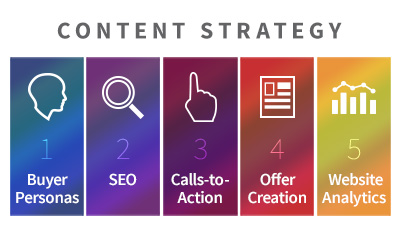What Is a Content Strategy?: How Planning Simplifies Your Marketing
 Businesspeople understand the need for a market strategy, some understand the need for a brand strategy but relatively new on the marketing landscape is the need for a “content strategy.” So, what is a content strategy, why do you need it and how do you create one?
Businesspeople understand the need for a market strategy, some understand the need for a brand strategy but relatively new on the marketing landscape is the need for a “content strategy.” So, what is a content strategy, why do you need it and how do you create one?
Having a content strategy is at the heart of what makes a website a lead generation tool vs. a static brochure-ware experience. Initially, the driving force behind corporate websites was that the technology existed to create them and that all of one’s competitors had one. The recipe for creating a website became standardized:
1. Create Information Architecture (IA) that would define all pages within the site
2. Design cool homepage with flashy motion graphics
3. Fill the pages indicated by the IA with lots of copy about what you do and pictures of your products or the attractive people that use them
4. Complete site development, and launch site
5. Let it sit for 5 years until competitors created better looking sites
6. Repeat Steps 1-5
Most B2B websites still follow this program, but smart businesses have realized that great content has lasting value when used purposefully. Content used to be “what you put into your pages,” and appeared in the website creation process only after the IA and design were completed.
How Content Strategy is Changing the Web
Today, with the benefit of advanced SEO and analytics, you have clear evidence that the content of your website is critical for attracting the right visitors and nurturing them along a path toward engaging with you.
Content creation has moved up the food chain to assume a critical, early role in the web creation process. A content strategy begins in lock step with the IA for a new website. Starting at the page level, we determine; What is the goal of each and every page? What would we like the visitor to do on each page?, i.e., Register for an offer like a white paper, webinar or event? Link to another page to learn more? Read a relevant blogpost? Watch a compelling video? Pick up the phone and call? In essence, every page is a home page in that you want to direct your visitor to take some kind of action.
All of this purposeful, marketing-focused, page content is then regularly measured through Google Analytics, or other tools for measuring the long-term effectiveness of marketing programs, such as HubSpot, Marketo or Pardot. The analytics then inform what content is generating interest and what is falling flat, which guides future decisions about what types of content needs to be created or embellished upon, what can be repurposed to other outlets like social media, blogs, etc., and what should be retired.
So, the new recipe for website creation —based on having a content strategy — goes something like this:
- Discuss strategic marketing goals with client
- Define Buyer Personas (demographics and psychographics) of your target audience
- Define SEO keywords and phrases
- Establish IA
- Create content and a library of content offers — based on the things your Buyer Personas suggest are relevant — and assign to IA
- Design cool homepage
- Design secondary page “templates,” which are a set of standard “page types” to which every page in the site will adhere
- Complete site development, and launch site
- Email launch announcements
- Prewrite blogposts and tweets to keep launch visible to clients and prospects
- Consult web analytics on a regular basis to inform ongoing content creation
- Continuously update site content, offers, and repurpose that content into blogs, articles and tweets
Yes, creating a content strategy has made the website process more complex and continuous in nature, but the value of your website will increase exponentially if you do! And you can be sure it’s what your competition is doing.
